Popular categories
Looking for a yarn?

65% Wool, 35% Alpaca
from 2.40 £ /50g
Order DROPS Kid-Silk from Wool Warehouse Direct Ltd

|
DROPS Kid-Silk uni colour 75% Mohair, 25% Silk |
4.60 £ /25g |
Order |
Clicking the ORDER button will redirect you to Wool Warehouse Direct Ltd website
Order DROPS Needles & Hooks
Clicking the ORDER button will redirect you to Wool Warehouse Direct Ltd website
The yarn cost is calculated from the pattern’s smallest size and the yarn’s cheapest product type. Looking for an even better price? You might find it on the DROPS Deals!
Winter Cocoon
Knitted shoulder piece in DROPS Lima and DROPS Kid-Silk. The piece is worked with textured pattern and rib. Sizes S - XXXL.
DROPS Design: Pattern no li-108
Yarn group B + A
-------------------------------------------------------
SIZES:
S/M – L/XL – XXL/XXXL
MATERIALS:
DROPS LIMA from Garnstudio (belongs to yarn group B)
450-500-550 g colour 9020, pearl grey
And use:
DROPS KID-SILK from Garnstudio (belongs to yarn group A)
100-100-125 g colour 01, off white
KNITTING TENSION:
13 stitches in width and 15 rows in height with stocking stitch/textured pattern and 1 strand of each quality = 10 x 10 cm.
NEEDLES:
DROPS CIRCULAR NEEDLE SIZE 7 MM: Length 80 cm.
DROPS CIRCULAR NEEDLE SIZE 6 MM: Length 40 cm and 80 cm for rib.
Needle size is only a guide. If you get too many stitches on 10 cm, change to a larger needle size. If you get too few stitches on 10 cm, change to a smaller needle size.
-------------------------------------------------------
Alternative Yarn – See how to change yarns here
Yarn Groups A to F – Use the same pattern and change the yarn here
Yarn usage using an alternative yarn – Use our yarn converter here
-------------------------------------------------------

65% Wool, 35% Alpaca
from 2.40 £ /50g
Order DROPS Lima from Wool Warehouse Direct Ltd

|
DROPS Kid-Silk uni colour 75% Mohair, 25% Silk 4.60 £ /25g Order |
Clicking the ORDER button will redirect you to Wool Warehouse Direct Ltd website
Order DROPS Needles & Hooks
Clicking the ORDER button will redirect you to Wool Warehouse Direct Ltd website
The yarn cost is calculated from the pattern’s smallest size and the yarn’s cheapest product type. Looking for an even better price? You might find it on the DROPS Deals!
- English (UK/cm)
- Česky - not translated
- Dansk
- Deutsch
- Eesti keel
- English (US/in)
- Español
- Français
- Íslenska
- Italiano
- Magyar
- Nederlands
- Norsk
- Polski
- Português
- Suomi
- Svenska
- English (UK/cm), Bulgaria
- English (UK/cm), Croatia
- English (UK/cm), Greece
- English (UK/cm), Latvia
- English (UK/cm), Lithuania
- English (UK/cm), Romania
- English (UK/cm), Slovenia
- Česky, Slovakia - not translated
Pattern instructions
EXPLANATIONS FOR THE PATTERN:
-------------------------------------------------------
RIDGE/GARTER STITCH (worked back and forth):
Knit all rows.
1 ridge in height = Knit 2 rows.
PATTERN:
See diagrams A.1 and A.2 – choose diagram for your size. The diagrams show all the rows in the pattern seen from the right side.
INCREASE TIP-1:
All increases are worked from the right side!
Increase 2-3-3 times in the piece, increasing 15-16-17 stitches each time.
First increase:
Work up to the first section with 4 purled stitches, purl 1, 1 yarn over, purl 3 (= 1 stitch increased). Repeat at each purled section. On the next row work the yarn overs twisted to avoid holes. Then work the new stitches into the pattern.
Second increase:
Work up to the first section with 4 purled stitches, purl 3, 1 yarn over, purl 1. Repeat at each purled section. On the next row work the yarn overs twisted to avoid holes. Then work the new stitches into the pattern.
Increases in size S/M have finished. In sizes L/XL and XXL/XXXL increase 1 more time as follows:
Third increase:
Work up to the first section with 5 purled stitches, purl 1, 1 yarn over, purl 4 (= 1 stitch increased). Repeat at each purled section. On the next row work the yarn overs twisted to avoid holes. Then work the new stitches into the pattern.
INCREASE TIP-2:
To work out how to increase evenly, count the total number of stitches on needle (e.g. 152 stitches) and divide by number of increases to be made (e.g. 34) = 4.8. In this example, increase by making 1 yarn over after approx. each 5th stitch. On the next row knit the yarn overs twisted to avoid holes.
-------------------------------------------------------
START THE PIECE HERE:
-------------------------------------------------------
SHOULDER PIECE – SHORT OVERVIEW OF THE PIECE:
The piece is worked back and forth with circular needle and then the sides are sewn together. Finally the edges are worked in rib, in the round with circular needle.
SHOULDER PIECE:
Cast on 122-130-138 stitches with circular needle size 7 mm and 1 strand Lima + 1 strand Kid-Silk (= 2 strands). Work pattern as follows: 1 edge stitch in GARTER STITCH – read description above, A.1 until there is 1 stitch left (= 15-16-17 repeats), 1 edge stitch in garter stitch. REMEMBER THE KNITTING TENSION! When the piece measures 16-19-21 cm – adjust so you finish after row 4 or 8 in the diagram, insert a marker in each side of the piece (= marks the beginning of the armholes). Continue with A.1 until the piece measures approx. 43-43-43 cm from the markers – adjust so you have an even number of squares in height (1 square = 4 rows of pattern A.1 in height). NOTE: This is important so the pattern is neat when assembling later on. Insert a new marker in each side of the piece. The 43 cm between the 2 markers on each side are the armholes. Continue with pattern as before. AT THE SAME TIME on the first row, increase 1 stitch in each purled section – read INCREASE TIP-1 (= 15-16-17 stitches increased) = 137-146-155 stitches. Continue with pattern as before, but now knit 4 and purl 5 stitches. The next time you begin a new square (with purl over knit and knit over purl), increase again in each purled section – remember INCREASE TIP-1 (= 15-16-17 stitches increased) = 152-162-172 stitches. Now the increases in size S/M are finished. In sizes L/XL and XXL/XXXL increase in the same way (in each purled section) the next time you start a new square in height = 152-178-189 stitches. Continue with pattern as before; i.e. work 4 rows in height with knit over knit and purl over purl, before switching to purl over knit and knit over purl as shown in A.2 – see diagram for your size. When the piece measures approx. 16-19-21 cm from the last marker – adjust so you have worked the same number of squares in height as are at the beginning of the piece (before the first markers were inserted for the armholes); the piece is now finished. and measures approx. 75-81-85 cm. Keep the 152-178-189 stitches on the needle.
ASSEMBLY:
Fold the piece in the middle so the cast-on edge lies along the 152-178-189 stitches on the needle. The 2 markers, which mark the armhole, should now lie above each other. Sew the side seams on each side; i.e. sew inside the 1 edge stitch in garter stitch on each side from the cast on/stitches on needle and as far as the 2 markers on the one side. Repeat on the other side.
EDGE AROUND OPENING:
Now work an edge with rib in the round as follows: Change to circular needle size 6 mm and 1 strand of each quality (= 2 strands) starting from the right side as follows: Knit the 152-178-189 stitches on the needle and increase at the same time 34-38-41 stitches evenly spaced – read INCREASE TIP-2, (= 186-216-230 stitches), then knit up 146-156-166 stitches evenly spaced over the cast-on edge = 332-372-396 stitches on the round. Now work rib (= knit 2 / purl 2) around the whole opening. When the rib measures 7-9-11 cm, cast off with knit over knit and purl over purl.
SLEEVE:
Knit up, from the right side around the armhole, 76-76-76 stitches inside the 1 edge stitch in garter stitch with short circular needle size 6 mm and 1 strand Lima + 1 strand Kid-Silk (= 2 strands). Work rib (= knit 2 / purl 2) in the round for 8 cm. Cast off with knit over knit and purl over purl. Work rib around the other armhole in the same way.
Diagram

|
= knit from right side, purl from wrong side |

|
= purl from right side, knit from wrong side |

|
= the sketch shows the piece after assembly |

|
= knitting direction |

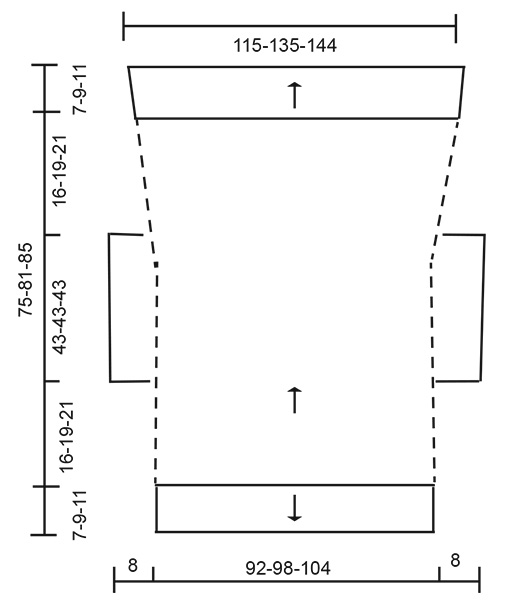

What can you do with our patterns? You can share DROPS patterns online, using the pattern original picture, materials, name and number. But you are NOT ALLOWED to reproduce the complete pattern digitally in any way. Yarn stores are welcome to use the DROPS pattern database to promote the sale of our assortment. You can print out our patterns, make as many copies as you’d like. The only thing we ask is that you don't make any changes / additions to the original printed document. And that the patterns according to the DROPS philosophy are given out to the consumers for free. Editorials that wish to publish our patterns in printed books or magazines can contact us for more information. The sale of garments based on DROPS patterns is permitted as long as they are sold as single items or per order. Further commercial use of the patterns is not permitted. It has to be clearly stated that the garment is made based on a design from DROPS DESIGN. The use of clothing labels of which DROPS DESIGN forms part is conditioned by the inclusion of the following text: “A DROPS DESIGN made by …..”. The use of DROPS photos for marketing purposes/sales is only permitted in connection with the use/sale of DROPS products. The photos may not be cut or edited and the logo should be clearly visible.
We reserve the right to withdraw the permission for use of our patterns at any time, notwithstanding the reason.
Each of our patterns has specific tutorial videos to help you.
These step-by-step tutorials might also help you:
Why is the knitting/crochet tension so important?
Knitting tension is what determines the final measurements of your work, and is usually measured per 10 x 10 cm. It is provided like so: number of stitches in width x number of rows in height - eg: 19 stitches x 26 rows = 10 x 10 cm.
The knitting tension is very individual; some people knit/crochet loosely while others work tightly. You adjust the knitting tension with the needle size, which is why the suggested needle size is only meant as a guide! You need to adjust this (up or down) to ensure that YOUR knitting tension matches the knitting tension provided in the pattern. If you work with a different knitting tension than provided you will have a different yarn consumption, and your work will have different measurements than what the pattern suggests.
The knitting tension also determines which yarns can replace each other. As long as you achieve the same knitting tension you can replace one yarn with another.
See DROPS lesson: How to measure your tension/gauge
See DROPS video: How to make a gauge tension swatch
How do I know how many balls of yarn I need?
The required amount of yarn is provided in grams, eg: 450 g. To calculate how many balls you’ll need you first need to know how many grams are in 1 ball (25g, 50g or 100g). This information is available if you click on the individual yarn quality on our pages. Divide the amount required with the amount of each ball. For example, if each ball is 50g (the most common amount), the calculation will be as follows: 450 / 50 = 9 balls.
Can I use a different yarn than what the pattern suggests?
The important thing when changing from one yarn to another is that the knitting/crochet tension remains the same. This is so that the measurements of the finished piece will be the same as on the sketch provided. It is easier to achieve the same knitting tension using yarns from the same yarn group. It is also possible to work with multiple strands of a thinner yarn to achieve the knitting tension of a thicker one. Please try our yarn converter. We recommend you to always work a test swatch.
Please NOTE: when changing yarn the garment might have a different look and feel to the garment in the photo, due to individual properties and qualities of each yarn.
See DROPS lesson: Can I use a different yarn than the one mentioned in the pattern?
What are the yarn groups?
All our yarns are categorised into yarn groups (from A to F) according to thickness and knitting tension – group A contains the thinnest yarns and group F the thickest. This makes it easier for you to find alternative yarns to our patterns, should you wish to switch yarn. All yarns within the same group have a similar knitting tension and can easily replace each other. However, different yarn qualities have different structures and properties which will give the finished work a unique look and feel.
How do I use the yarn calculator?
At the top of all our patterns you’ll find a link to our yarn calculator, which is a helpful tool should you wish to use a different yarn than suggested. By filling in the yarn quality you wish to replace, the amount (in your size) and number of strands, the calculator will present good alternative yarns with the same knitting tension. Additionally it will tell you how much you’ll require in the new qualities and whether you’ll need to work with multiple strands. Most skeins are 50g (some are 25g or 100g).
If the pattern is worked with multiple colours, every colour will have to be calculated separately. Similarly, if the pattern is worked with several strands of different yarns (for example 1 strand Alpaca and 1 strand Kid-Silk) you will have to find alternatives for each, individually.
Why do you show discontinued yarns in the patterns?
Since different yarns have different qualities and textures we have chosen to keep the original yarn in our patterns. However, you can easily find options among our available qualities by using our yarn calculator, or simply pick a yarn from the same yarn group.
It is possible that some retailers still have discontinued yarns in stock, or that someone has a few skeins at home that they would like to find patterns for.
The yarn calculator will provide both alternative yarn as well as required amount in the new quality.
What size should I knit?
If you think it's hard to decide what size to make, it can be a good idea to measure a garment you own already and like the size of. Then you can pick the size by comparing those measures with the ones available in the pattern's size chart.
You'll find the size chart at the bottom of the pattern.
See DROPS lesson: How to read size chart
Why do I get the wrong knitting tension with the suggested needle size?
The needle size provided in the pattern serves only as a guide, the important thing is to follow the knitting tension. And since knitting tension is very individual, you will have to adjust the needle size to ensure that YOUR tension is the same as in the pattern – maybe you’ll have to adjust 1, or even 2 needle sizes, up or down to achieve the correct tension. For this, we recommend that you work test swatches.
Should you work with a different knitting tension than the one provided, the measurements of the finished garment might deviate from the measurement sketch.
See DROPS lesson: How to measure your tension/gauge
See DROPS video: How to make a tension/gauge swatch
Why is the pattern worked top-down?
Working a garment top-down provides more flexibility and room for personal adjustment. For example it is easier to try the garment on while working, as well as making adjustments to length of yoke and shoulder caps.
The instructions are carefully explaining every step, in the correct order. Diagrams are adjusted to the knitting direction and are worked as usual.
How do I work according to a knitting diagram?
The diagram depicts all rows/rounds, and every stitch seen from the right side. It is read from bottom to top, from right to left. 1 square = 1 stitch.
When working back and forth, every other row is worked from the right side and every other row is worked from the wrong side. When working from the wrong side, the diagram will have to be worked reversed: from left to right, knit stitches are purled, purl stitches are knit etc.
When working in the round every round is worked from the right side and the diagram are worked from right to left on all rounds.
See DROPS lesson: How to read knitting diagrams
How do I work according to a crochet diagram?
The diagram depicts all rows/rounds, and every stitch seen from the right side. It is worked from bottom to top, from right to left.
When working back and forth every other row is worked from the right side: from right to left and every other row is worked from the wrong side: from left to right.
When working in the round, every row in the diagram are worked from the right side, from right to left.
When working a circular diagram you start in the middle and work your way outwards, counter clockwise, row by row.
The rows usually start with a given number of chain stitches (equivalent to the height of the following stitch), this will either be depicted in the diagram or explained in the pattern.
See DROPS lesson: How to read crochet diagrams
How do I work several diagrams simultaneously on the same row/round?
Instructions for working several diagrams after each other on the same row/round, will often be written like so: “work A.1, A.2, A.3 a total of 0-0-2-3-4 times". This means you work A.1 once, then A.2 is worked once, and A.3 is repeated (in width) the number of times provided for your size – in this case like so: S = 0 times, M = 0 times, L=2 times, XL= 3 times and XXL = 4 times.
The diagrams are worked as usual: begin with the first row in A.1, then work the first row in A.2 etc.
See DROPS lesson: How to read knitting diagrams
See DROPS lesson: How to read crochet diagrams
Why are the sleeves shorter in larger sizes?
The total width of the garment (from wrist-to-wrist) will be larger in the larger sizes, despite the actual sleeves being shorter. The larger sizes have longer sleeve caps and wider shoulders, so there will be a good fit in all sizes.
Where on the garment is the length measured?
The measurement sketch/schematic drawing provides information regarding the full length of the garment. If it’s a jumper or a jacket the length is measured from the highest point on the shoulder closest to the neckline, and straight down to the bottom of the garment. It is NOT measured from the tip of shoulder. Similarly, the length of yoke is measured from the highest point on the shoulder and down to where yoke is split into body and sleeves.
On a jacket measures are never taken along bands, unless specifically stated. Always measure inside band stitches when measuring the length.
See DROPS lesson: How to read a schematic drawing
What is a repeat?
Diagrams are often repeated on the round or in height. 1 repeat is the diagram the way it appears in the pattern. If it says to work 5 repeats of A.1 in the round, then you work A.1 a total of 5 times after/next to each other in the round. If it says to work 2 repeats of A.1 vertically/in height you work the entire diagram once, then begin again at the start and work the entire diagram one more time.
Why does the piece start with more chain stitches than it’s worked with?
Chain stitches are slightly narrower than other stitches and to avoid working the cast-on edge too tight, we simply chain more stitches to begin with. The stitch count will be adjusted on the following row to fit the pattern and measurement sketch.
Why increase before the rib edge when the piece is worked top-down?
The rib edge is more elastic and will contract slightly compared to, for example, stocking stitch. By increasing before the rib edge, you avoid a visible difference in width between the rib edge and the rest of the body.
Why increase in the cast-off edge?
It’s very easy to cast off too tightly, and by making yarn overs while casting off (and simultaneously casting these off) you avoid a too tight cast off edge.
See DROPS video: How to bind off with yarn overs (yo)
How do I increase/decrease on every 3rd and 4th row/round alternately?
To achieve an even increase (or decrease) you can increase on, for example: every 3rd and 4th row alternately, like so: work 2 rows and increase on the 3rd row, work 3 rows and increase on the 4th. Repeat this until the increase is complete.
See DROPS lesson: Increase or decrease 1 st on every 3rd and 4th row alternately
How can I work a jacket in the round instead of back and forth?
Should you prefer to work in the round instead of back and forth, you may of course adjust the pattern. You’ll need to add steeks mid-front (usually 5 stitches), and follow the instructions. When you would normally turn and work from the wrong side, simply work across the steek and continue in the round. At the end you’ll cut the piece open, pick up stitches to work bands, and cover the cut edges.
See DROPS video: How to knit steeks and cut open
Can I work a jumper back and forth instead of in the round?
Should you prefer to work back and forth instead of in the round, you may of course adjust the pattern so you work the pieces separately and then assemble them at the end. Divide the stitches for the body in 2, add 1 edge stitch in each side (for sewing) and work the front and back pieces separately.
See DROPS lesson: Can I adapt a pattern for circular needles into straight needles?
Why is the pattern slightly different than what I see in the photo?
Pattern repeats can vary slightly in the different sizes, in order to get the correct proportions. If you’re not working the exact same size as the garment in the photo, yours might deviate slightly. This has been carefully developed and adjusted so that the complete impression of the garment is the same in all sizes.
Make sure to follow instructions and diagrams for your size!
How do I make a women’s size garment into a men’s size one?
If you have found a pattern you like which is available in women’s size it’s not very difficult to convert it to men’s size. The biggest difference will be the length of sleeves and body. Start working on the women size that you think would fit across the chest. The additional length will be worked right before you cast off for the armhole/sleeve cap. If the pattern is worked top-down you can add the length right after the armhole or before the first decrease on sleeve.
Regarding additional yarn amount, this will depend on how much length you add, but it is better with a skein too many than too few.
How do I prevent a hairy garment from shedding?
All yarns will have excess fibres (from production) that might come off as lint or shedding. Brushed yarns (ie hairier yarns) have more of these loose, excess fibres, causing more shedding.
Shedding also depends on what is worn under or over the garment, and whether this pulls at the yarn fibres. It’s therefore not possible to guarantee that there will be no shedding
Below are some tips on how to get the best result when working with hairier yarns:
1. When the garment is finished (before you wash it) shake it vigorously so the looser hairs come off. NOTE: do NOT use a lint roller, brush or any method that pulls at the yarn.
2. Place the garment in a plastic bag and put it in your freezer - the temperature will cause the fibres to become less attached to each other, and excess fibres will come off easier.
3. Leave in the freezer for a few hours before taking it out and shaking it again.
4. Wash the garment according to the instructions on the yarn label.
Why does my garment pill?
Pilling is a natural process that happens to even the most exclusive of fibers. It's a natural sign of wear and tear that is hard to avoid, and that is most visible in high friction areas of your garment like a sweater's arms and cuffs.
You can make your garment look as new by removing the pilling, using a fabric comb or a pill/lint remover.
In the meantime, you can read the questions and answers that others have left to this pattern or join the DROPS Workshop on Facebook to get help from fellow knitters/crocheters!
You might also like...
Winter Cocoon |
|||||||||||||
 |
 |
||||||||||||
Knitted shoulder piece in DROPS Lima and DROPS Kid-Silk. The piece is worked with textured pattern and rib. Sizes S - XXXL.
DROPS 207-32 |
|||||||||||||
|
------------------------------------------------------- EXPLANATIONS FOR THE PATTERN: ------------------------------------------------------- RIDGE/GARTER STITCH (worked back and forth): Knit all rows. 1 ridge in height = Knit 2 rows. PATTERN: See diagrams A.1 and A.2 – choose diagram for your size. The diagrams show all the rows in the pattern seen from the right side. INCREASE TIP-1: All increases are worked from the right side! Increase 2-3-3 times in the piece, increasing 15-16-17 stitches each time. First increase: Work up to the first section with 4 purled stitches, purl 1, 1 yarn over, purl 3 (= 1 stitch increased). Repeat at each purled section. On the next row work the yarn overs twisted to avoid holes. Then work the new stitches into the pattern. Second increase: Work up to the first section with 4 purled stitches, purl 3, 1 yarn over, purl 1. Repeat at each purled section. On the next row work the yarn overs twisted to avoid holes. Then work the new stitches into the pattern. Increases in size S/M have finished. In sizes L/XL and XXL/XXXL increase 1 more time as follows: Third increase: Work up to the first section with 5 purled stitches, purl 1, 1 yarn over, purl 4 (= 1 stitch increased). Repeat at each purled section. On the next row work the yarn overs twisted to avoid holes. Then work the new stitches into the pattern. INCREASE TIP-2: To work out how to increase evenly, count the total number of stitches on needle (e.g. 152 stitches) and divide by number of increases to be made (e.g. 34) = 4.8. In this example, increase by making 1 yarn over after approx. each 5th stitch. On the next row knit the yarn overs twisted to avoid holes. ------------------------------------------------------- START THE PIECE HERE: ------------------------------------------------------- SHOULDER PIECE – SHORT OVERVIEW OF THE PIECE: The piece is worked back and forth with circular needle and then the sides are sewn together. Finally the edges are worked in rib, in the round with circular needle. SHOULDER PIECE: Cast on 122-130-138 stitches with circular needle size 7 mm and 1 strand Lima + 1 strand Kid-Silk (= 2 strands). Work pattern as follows: 1 edge stitch in GARTER STITCH – read description above, A.1 until there is 1 stitch left (= 15-16-17 repeats), 1 edge stitch in garter stitch. REMEMBER THE KNITTING TENSION! When the piece measures 16-19-21 cm – adjust so you finish after row 4 or 8 in the diagram, insert a marker in each side of the piece (= marks the beginning of the armholes). Continue with A.1 until the piece measures approx. 43-43-43 cm from the markers – adjust so you have an even number of squares in height (1 square = 4 rows of pattern A.1 in height). NOTE: This is important so the pattern is neat when assembling later on. Insert a new marker in each side of the piece. The 43 cm between the 2 markers on each side are the armholes. Continue with pattern as before. AT THE SAME TIME on the first row, increase 1 stitch in each purled section – read INCREASE TIP-1 (= 15-16-17 stitches increased) = 137-146-155 stitches. Continue with pattern as before, but now knit 4 and purl 5 stitches. The next time you begin a new square (with purl over knit and knit over purl), increase again in each purled section – remember INCREASE TIP-1 (= 15-16-17 stitches increased) = 152-162-172 stitches. Now the increases in size S/M are finished. In sizes L/XL and XXL/XXXL increase in the same way (in each purled section) the next time you start a new square in height = 152-178-189 stitches. Continue with pattern as before; i.e. work 4 rows in height with knit over knit and purl over purl, before switching to purl over knit and knit over purl as shown in A.2 – see diagram for your size. When the piece measures approx. 16-19-21 cm from the last marker – adjust so you have worked the same number of squares in height as are at the beginning of the piece (before the first markers were inserted for the armholes); the piece is now finished. and measures approx. 75-81-85 cm. Keep the 152-178-189 stitches on the needle. ASSEMBLY: Fold the piece in the middle so the cast-on edge lies along the 152-178-189 stitches on the needle. The 2 markers, which mark the armhole, should now lie above each other. Sew the side seams on each side; i.e. sew inside the 1 edge stitch in garter stitch on each side from the cast on/stitches on needle and as far as the 2 markers on the one side. Repeat on the other side. EDGE AROUND OPENING: Now work an edge with rib in the round as follows: Change to circular needle size 6 mm and 1 strand of each quality (= 2 strands) starting from the right side as follows: Knit the 152-178-189 stitches on the needle and increase at the same time 34-38-41 stitches evenly spaced – read INCREASE TIP-2, (= 186-216-230 stitches), then knit up 146-156-166 stitches evenly spaced over the cast-on edge = 332-372-396 stitches on the round. Now work rib (= knit 2 / purl 2) around the whole opening. When the rib measures 7-9-11 cm, cast off with knit over knit and purl over purl. SLEEVE: Knit up, from the right side around the armhole, 76-76-76 stitches inside the 1 edge stitch in garter stitch with short circular needle size 6 mm and 1 strand Lima + 1 strand Kid-Silk (= 2 strands). Work rib (= knit 2 / purl 2) in the round for 8 cm. Cast off with knit over knit and purl over purl. Work rib around the other armhole in the same way. |
|||||||||||||
Diagram explanations |
|||||||||||||
|
|||||||||||||

|
|||||||||||||

|
|||||||||||||

|
|||||||||||||
|
Have you made this or any other of our designs? Tag your pictures in social media with #dropsdesign so we can see them! Do you need help with this pattern?You'll find tutorial videos, a Comments/Questions area and more by visiting the pattern on garnstudio.com. © 1982-2024 DROPS Design A/S. We reserve all rights. This document, including all its sub-sections, has copyrights. Read more about what you can do with our patterns at the bottom of each pattern on our site. |
|||||||||||||
With over 40 years in knitting and crochet design, DROPS Design offers one of the most extensive collections of free patterns on the internet - translated to 17 languages. As of today we count 304 catalogues and 11422 patterns - 11422 of which are translated into English (UK/cm).
We work hard to bring you the best knitting and crochet have to offer, inspiration and advice as well as great quality yarns at incredible prices! Would you like to use our patterns for other than personal use? You can read what you are allowed to do in the Copyright text at the bottom of all our patterns. Happy crafting!








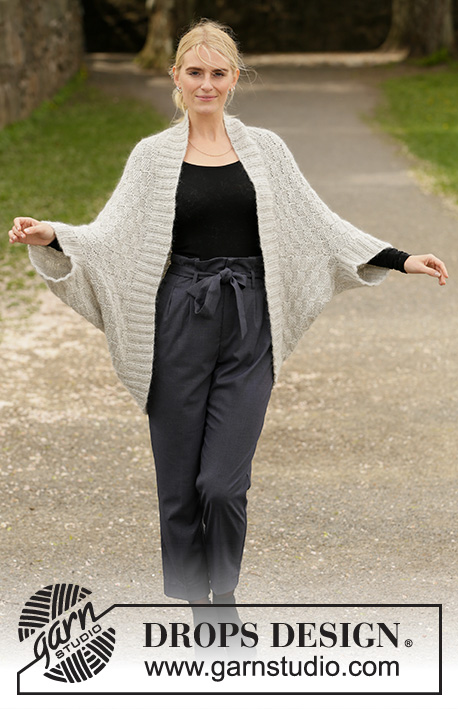



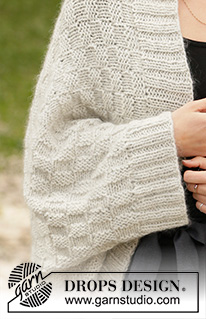
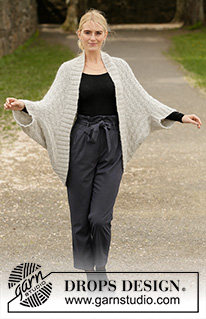





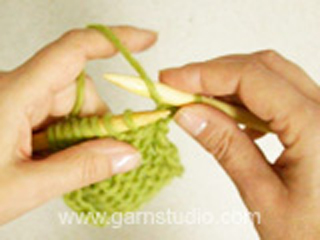

































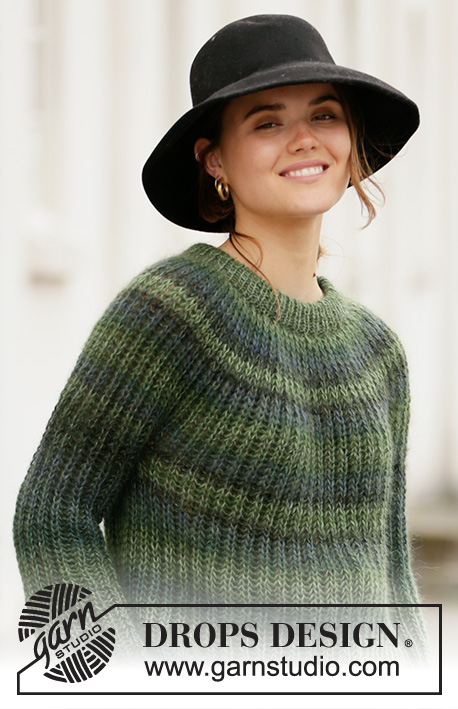
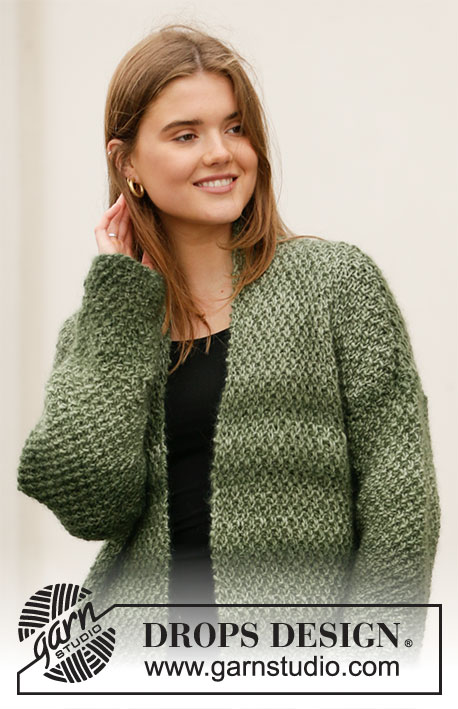
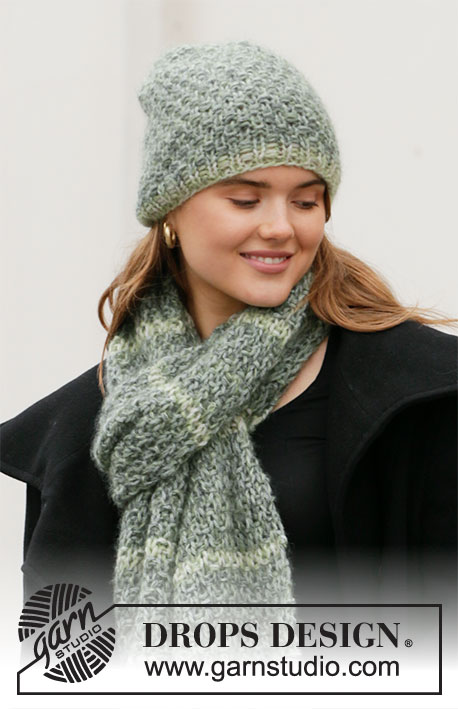






Comments / Questions (28)
Buenas noches. Me podría indicar en qué momento se inician los aumentos. ¿Al terminar los 43 cm de la manga? O antes? En el esquema parece que es antes de terminar la manga. Gracias.
19.04.2021 - 04:22DROPS Design answered:
Hola Luz Maria. Los aumentos se comienzan después de terminar las sisas, en caso contrario las sisas no quedarían iguales. En caso de duda, sigue siempre las instrucciones del texto, ya que el dibujo final es simplemente un esquema.
24.04.2021 - 20:15Bonjour, pour celles qui l'ont réalisé, je fais du XL est ce que la taille L/XL est assez grand? merci pour votre réponse
26.05.2020 - 16:47Bonsoir et merci pour la rapidité de votre réponse. Je viens tout juste de terminer mon ouvrage et je suis très contente du résultat. Merci pour tous vos modèles du plus simple au plus original. J’aime particulièrement ceux qui associent 2 types de fils. J’ai déjà tricoté avec succès plusieurs pulls qui combinent kid-silk avec un fil du groupe A. Je trouve que cette association convient bien aux motifs ajourés.
01.05.2020 - 20:47Bonsoir Je tricote la taille L/XL et je suis arrivée à la partie assemblage. Il est écrit : plier l’ouvrage au milieu pour que les 178 mailles du montage soient contre celles sur l’aiguille. Mais il y a 130 mailles de montage et pas 178. Les 178 mailles sont sur l’aiguille. N’y a-t-il pas une erreur ? Merci de bien vouloir me répondre.
28.04.2020 - 21:55DROPS Design answered:
Bonjour Mme Gazania, effectivement, il semble qu'il y ait une erreur, vous pliez bien l'ouvrage pour que les mailles du montage se trouvent contre les 152-178-189 mailles sur l'aiguille, la correction va être faite, merci. Bon tricot!
29.04.2020 - 09:04The pattern is great, but I have a size issue. Which size is on the model on photo? Cause I’m almost finished the main part and it doesn’t look like sweater on the photo at all. Thanks!
23.02.2020 - 18:41DROPS Design answered:
Dear Julia. The model in the picture is approx. 170 cm and is size S or M.
23.02.2020 - 23:41Bonjour, Je commence le tricot et j'ai pris des aiguilles 6. Il me semble que je pourrais prendre du 5,5. Vous pensez que c'est souhaitable,?
12.01.2020 - 10:05DROPS Design answered:
Bonjour Thérèse, avez-vous fait votre échantillon? Si votre tension est juste avec les aiguilles 7, vous pouvez alors utiliser les aiguilles 6 - plus d'infos ici. Bon tricot!
13.01.2020 - 09:45Bonjour que signifie le petit logo "montre" sur la page de présentation ? Modèle rapide à réaliser ? Ou modèle long à réaliser ?
12.10.2019 - 20:22DROPS Design answered:
Bonjour Charlotte78, ce logo indique simplement que c'est un modèle qui a été ajouté récemment. Bon tricot!
14.10.2019 - 09:59Wanneer komt dit leuke vest als patroon beschikbaar. het lijkt of er geen patronen bijkomen
27.09.2019 - 17:25Glæder mig til opskriften ligger klar. Er totalt faldet for den.
04.09.2019 - 19:55Superbe veste
26.07.2019 - 20:49